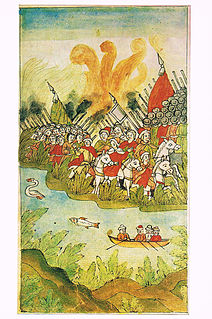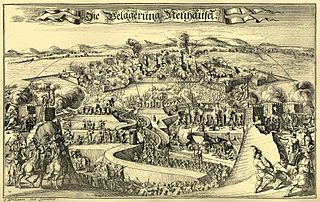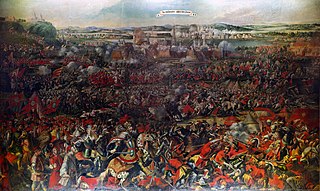 W
WThe Azov campaigns of 1695–96, were two Russian military campaigns during the Russo-Turkish War of 1686–1700, led by Peter the Great and aimed at capturing the Turkish fortress of Azov, which had been blocking Russia's access to the Azov Sea and the Black Sea. Since the Crimean campaigns of 1687 and 1689 had failed because of the difficulty of moving a large army across the steppe, Peter decided to try a river approach.
 W
WThe Battle of Batočina was fought on 29–30 August 1689 near the town of Batočina in the Sanjak of Smederevo, between Holy Roman and Ottoman forces during the Great Turkish War (1683–99).
 W
WThe Battle of Párkány was a battle fought between October 7–9, 1683 in the town of Párkány, in the Ottoman Empire, and the area surrounding it as part of the Polish-Ottoman War and the Great Turkish War. The battle was fought in two stages. In the first stage Polish troops under John III Sobieski were defeated by the Ottoman army under Kara Mehmed Pasha on October 7, 1683. In the second stage Sobieski, supported by Austrian forces under Charles V, Duke of Lorraine, defeated the Ottoman forces, which were supported by the troops of Imre Thököly, and gained control of Párkány on October 9, 1683. After the Ottoman defeat, the Austrians would besiege Esztergom and captured it at the end of 1683.
 W
WThe Battle of Ulaş (1696) or Battle at the Bega River was a battle near the Bega River between the army of the Ottoman Empire under command of Mustafa II and the forces of the Habsburg Empire under command of Augustus II the Strong.
 W
WThe Siege of Buda (1686) was fought between the Holy League and the Ottoman Empire, as part of the follow-up campaign in Hungary after the Battle of Vienna. The Holy League took Buda after a long siege.
 W
WIn the spring of 1684 an army of about 43,000 men marched under Charles V, Duke of Lorraine to capture the city of Buda from the Turks. After the main army crossed the Danube at Esztergom on 13 June, the front of the imperial army under the command of Maximilian Lorenz Starhemberg and the cavalry Gen. Louis William, Margrave of Baden-Baden arrived at the castle town of Visegrád on 15 June. On 16 June the town of Esztergom was taken by storm by imperial troops in spite of its strong walls, after a gate was destroyed by cannons. The majority of the Turkish occupation troops were killed and the city was plundered. Only a few Turks managed to withdraw to the castle on the rock above the city. After a siege of 1-1/2 days, the remaining Turkish garrison capitulated on 18 June.
 W
WThe Crimean campaigns of 1687 and 1689 were two military campaigns of the Tsardom of Russia against the Crimean Khanate. They were a part of the Russo-Turkish War (1686–1700) and Russo-Crimean Wars. These were the first Russian forces to come close to Crimea since 1569. They failed due to poor planning and the practical problem of moving such a large force across the steppe but nonetheless played a key role in halting the Ottoman expansion in Europe. The campaigns came as a surprise for the Ottoman leadership, spoiled its plans to invade Poland and Hungary and forced it to move significant forces from Europe to the east, which greatly helped the League in its struggle against the Ottomans.
 W
WThe Siege of Érsekújvár was fought between July 7 and August 17 of 1685, between the besieging Habsburg army and the Ottoman garrison of Érsekújvár, city in what is today Nové Zámky, Slovakia . The Austrian commander, Aeneas de Caprara, invested the city and stormed it on August 17, slaying the entire Ottoman garrison.
 W
WThe Second Battle of Mohács, also known as the Battle of Harsány Mountain, was fought on 12 August 1687 between the forces of Ottoman Sultan Mehmed IV, commanded by the Grand-Vizier Sari Süleyman Paşa, and the forces of Holy Roman Emperor Leopold I, commanded by Charles of Lorraine. The result was a defeat for the Ottomans.
 W
WThe Battle of Niš was fought on 24 September 1689, near the city of Niš in southern Serbia, between the forces of the Ottoman Empire, and the forces of the Holy Roman Empire as part of the Great Turkish War.
 W
WThe Battle of Podhajce was fought in the town of Podhajce in the Polish-Lithuanian Commonwealth, and the area surrounding it as part of the Polish-Tartar War and the Great Turkish War. The army of the Polish-Lithuanian Commonwealth under John III Sobieski, totaling around 9,000 men defeated Tatar and Cossack forces under Petro Doroshenko and Adil Giray, which totaled around 35,000 men.
 W
WThe Siege of Santa Maura took place on 21 July – 6 August 1684 between the forces of the Republic of Venice and the Ottoman Empire, and was the opening battle of the Sixth Ottoman–Venetian War.
 W
WThe Siege of Belgrade in 1688 was the fourth siege of that city, taking place during the Great Turkish War.
 W
WThe Battle of Slankamen was fought on 19 August 1691, near Slankamen in the Ottoman Sanjak of Syrmia, between the Ottoman Empire, and Habsburg Austrian forces during the Great Turkish War.
 W
WThe Battle of Vác was fought on June 27, 1684, near the city of Vác in central Hungary, between the forces of the Ottoman Empire, and the forces of the Holy Roman Empire as part of the Great Turkish War. The Austrian army was victorious.
 W
WThe Battle of Vienna took place at Kahlenberg Mountain near Vienna on 12 September 1683 after the imperial city had been besieged by the Ottoman Empire for two months. The battle was fought by the Holy Roman Empire led by the Habsburg Monarchy and the Polish–Lithuanian Commonwealth, both under the command of King John III Sobieski, against the Ottomans and their vassal and tributary states. The battle marked the first time the Commonwealth and the Holy Roman Empire had cooperated militarily against the Ottomans, and it is often seen as a turning point in history, after which "the Ottoman Turks ceased to be a menace to the Christian world". In the ensuing war that lasted until 1699, the Ottomans lost almost all of Hungary to the Holy Roman Emperor Leopold I.
 W
WThe Battle of Zenta, was fought on 11 September 1697, near Zenta, Ottoman empire, between Ottoman and Holy League armies during the Great Turkish War. The battle was the most decisive engagement of the war, and it saw the Ottomans suffer an overwhelming defeat by an Imperial force one third as large commanded by Prince Eugene of Savoy.